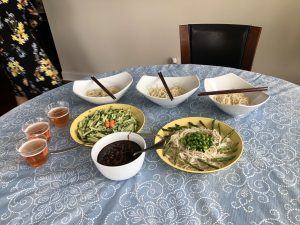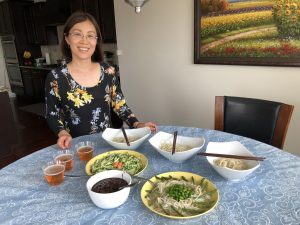Zoe Walker
From the very beginning, this ethnographic interview has opened my eyes and deepened my understanding of the cultural and historical influence food plays in people’s lives. Starting from the first moment I entered Dr. Li’s house I began learning and witnessing her culture and customs even outside of noodles. When I first walked in, I noticed right by the door there was a row of shoes neatly lined up and it was clear I was supposed to remove my shoes as well. Dr. Li then provided me with a pair of comfortable slippers for me to put on and wear throughout the interview. This showed me that not only are Chinese traditions in connection to noodles important in her daily life but other Chinese customs as well. By participating in this act of removing my shoes I felt like I was paying respect to her culture while also getting to experience it. From then on, I was able to learn a lot about China’s history with noodles but more specifically Dr. Li’s history with noodles and how it’s similar and different to traditional Chinese practices.
Dr. Li was born in a city next to Beijing, China where she lived all throughout her school years. Since there is no undergraduate school in China, after graduating high school Dr. Li went straight into graduate school. Dr. Li attended Beijing Medical University for 5 years where she got a degree in pediatrics. She then graduated and began working in Beijing in pediatrics and research for six years. Following this, she worked in two other countries, Japan and Finland, before moving to the United States in 2005. Dr. Li now works at Emory University where she is a Physician Researcher and works in the Genetics Department as a Geneticist. Throughout all the years of living in different countries, Chinese noodles have constantly influenced Dr. Li culturally in many different ways. As a result of spending so many of her younger years in China, Dr. Li has a strong connection and nostalgia associated with Chinese dishes. During the interview, Dr. Li mentions how when she was younger certain dishes reminded her of different memories and how today she tries to bring back those memories by recreating the same dishes that she made when she was young. These specific noodle dishes have provided her with a connection to her culture and allowed her to maintain these traditions that she might have lost over time. Another way Chinese noodles have influenced Dr. Li’s culture is that she has begun a tradition of making Chinese dishes with her daughter who was raised in the United States. The Chinese noodle dishes they make together allow her daughter to experience China’s culture even though she wasn’t born and raised there. She mentioned a Chinese dish called Zha Jiang Mian that she describes as a sesame sauce. The sesame seeds are ground up to retain the oil and a sesame paste deposit which is mixed with water to create the sauce. You can then add in garlic and oil and then it is put on over the noodles. This is her daughter’s favorite dish and she mentions that whenever she makes it her daughter will join in and help create the sauce, and it is a dish that they enjoy making together. This dish is a vessel that allows Dr. Li and her daughter to connect while also providing an experience for her daughter to cook an authentic Chinese dish that is a part of both of their history and culture. During the interview, Dr. Li talked about how her culture is also influenced by the region that the noodle dishes are made in. In China, the popular dishes you consume are dependent on the province you are in, so the influences that affect your dish making can change from place to place. Dishes from other provinces such as Sichuan Dan Dan Mian noodles and Shanxi Dao Xiao Mian noodles, which are more commonly known as knife-cut noodles, have both been incorporated in the list of noodle dishes that Dr. Li enjoys. As a result of Dr. Li traveling from region to region and immersing in the culture of that specific region, the variety of dishes she encounters adds another layer to her culture and history.
While we mentioned many delicious dishes that have all influenced Dr. Li’s history, her favorite dish and the one we made together is Zha Jiang Mian. This name has different connotations such as “noodles with soybean paste” or “fried sauce”. These meanings come from the incorporation of soybean paste in the sauce which is then stir-fried with pork, eggs and other ingredients. Dr. Li mentions that this dish originated in the Shandong province and there is an ancient fable of how it migrated to Beijing. When an empress tried this dish after a long days travel and loved it, she decided to take this dish with her to the forbidden city in Beijing where it was tried and loved by all the emperors and empresses. It was then incorporated in the Beijing region and has become a popular dish ever since. There is also a cultural tradition associated with this noodle that Dr. Li partakes in. This dish is eaten for three reasons: three days after a person is born, three days after they pass and every year in between on their birthday to increase the longevity of their life. Since it was my sister’s birthday on the day of this interview, it was perfectly fitting for us to create this dish. Regarding the ingredients, wheat production is very common in northern China and as a result of this regional influence, Zha Jiang Mian noodles are made with wheat flour. While this component has been kept consistent, Over time the changes in China’s society has influenced other factors in the making of this noodle dish. Dr. Li mentioned while we were cooking that even though it was originally common to make the dough with just flour and water, over time there has been an incorporation of adding in a milk and egg mixture to incorporate more nutrition into the noodles. In the earlier centuries of China when there were more poor and rural communities it was common to use water to make the flour as it was cheaper. As China has grown and prospered over time, the incorporation of ingredients that are considered more expensive such as milk and eggs can be added to the dish to obtain a higher nutritional value. Another change that Dr. Li has incorporated into this dish and her diet is the use of lean pork when cooking the Zha Jiang Mian. In China, it is traditional to use fatty pork but as information has come out on the importance of a healthy diet, Chinese societies have adapted to incorporate healthier options.
During the interview, Dr. Li also talks about how American culture has influenced the dishes she eats and makes today. Dr. Li mentions that when she came to America many of the Chinese dishes she encountered were Chow Mein or Lo Mein which, while they are common here in America, they are not as common in China. She mentions that when you do see it in China it is usually not homemade because it is not a traditional Chinese dish. As a result, this was a cultural change that she had to adapt to especially if she would go to a Chinese restaurant instead of cooking at home. Another way that American culture has manifested itself in the noodle dishes Dr. Li makes is in the vegetables she uses in her dishes. During the interview, Dr. Li mentions that her daughter grew up eating the vegetables common in American and when she found vegetables at the Chinese market that you wouldn’t normally find in a regular grocery store, her daughter never fully adapted to the taste. As a result, Dr. Li has incorporated various American vegetables into her Chinese dishes instead of Chinese vegetables. One example is in the Zha Jiang Mien noodles. While she still included beansprouts, cucumbers and carrots, Dr. Li incorporated asparagus which is not a common vegetable used in Zha Jiang Mian. She also did not incorporate Chinese cabbage and radishes which is common in a traditional Chinese rendition of this dish. American influence has also become a part of the cultural DNA of the noodles Dr. Li consumes by the incorporation of instant noodles in some of her dishes. In Chinese culture, it is a tradition to make homemade noodles due to its authenticity and freshness, two key factors when making traditional Chinese noodles. This is also the form of noodles that Dr. Li prefers, but over time, living in the United States, Dr. Li has incorporated American adaptations of noodles such as dry and instant noodles. While not as often eat at home, these forms of noodles have become another part of Dr. Li’s cultural history with noodles.
Overall, through both anthropological methods of interview and participant-observation, I was able to learn and increase my knowledge on the cultural impacts noodles have had on Dr. Li’s life. Through this experience, I have gained insight into parts of the Chinese culture that I could not have obtained otherwise. I have also been able to experience making a traditional Chinese dish and see how both Chinese societal changes and American influences have impacted the noodle dishes that are considered a part of Dr. Li’s history. By not only getting to interview Dr. Li but also be a part of making Zha Jiang Mian I was able to immerse myself in the Chinese culture while making a dish to celebrate another year of long life for a family member I care for. This I believe is a model illustration of how Chinese noodles can have a personal influence on history and culture.


link to the video: https://youtu.be/qwk0t2c4By4
